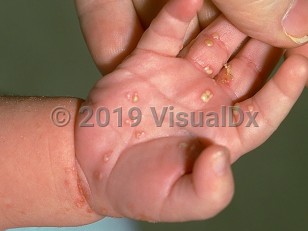Neonatal candidiasis
Alerts and Notices
Important News & Links
Synopsis

Neonatal candidiasis can develop perinatally or postnatally: it can be acquired by passage through an infected birth canal, develop postnatally from invasive procedures or infected catheters, or be related to breaks in the skin of the neonate. It is seen after the first week of life, in contrast to congenital candidiasis, which is present at birth.
Affected infants may present with a varying clinical picture.
Localized Disease
Localized disease is limited to the development of mucocutaneous lesions and usually presents as thrush or diaper dermatitis, but other intertriginous areas may be involved.
Systemic Infection
A more widespread systemic infection occurs mostly in low birth weight infants. Cutaneous findings include diffuse erythema, vesicles, or pustules. The infant is lethargic, refuses to feed, is apneic, or is in respiratory distress. Temperature instability and hyperglycemia are seen. Meningitis, urinary tract infection, or candidal septicemia may occur. More severe cases may result in multiorgan failure.
Widespread Cutaneous Infection
The development of a widespread cutaneous candidal infection that resembles an erosive dermatitis may also be seen in extremely low birth weight infants. Risk factors for the development of this type of neonatal candidiasis include prematurity, abdominal surgery, intravenous (IV) catheterization, and broad-spectrum antibiotic use as well as steroid administration and hyperglycemia. Infants with widespread cutaneous involvement can present with macular, papular, vesicular, or pustular lesions. Erosive and ulcerative lesions develop with crust formation.
Candida auris is an emerging cause of candidemia that is notable for high rates of mortality and for drug resistance. Candida auris mostly affects patients with severe underlying medical conditions requiring complex medical care. Consultation with an infectious disease specialist is highly recommended when caring for patients with C auris infection.
Affected infants may present with a varying clinical picture.
Localized Disease
Localized disease is limited to the development of mucocutaneous lesions and usually presents as thrush or diaper dermatitis, but other intertriginous areas may be involved.
Systemic Infection
A more widespread systemic infection occurs mostly in low birth weight infants. Cutaneous findings include diffuse erythema, vesicles, or pustules. The infant is lethargic, refuses to feed, is apneic, or is in respiratory distress. Temperature instability and hyperglycemia are seen. Meningitis, urinary tract infection, or candidal septicemia may occur. More severe cases may result in multiorgan failure.
Widespread Cutaneous Infection
The development of a widespread cutaneous candidal infection that resembles an erosive dermatitis may also be seen in extremely low birth weight infants. Risk factors for the development of this type of neonatal candidiasis include prematurity, abdominal surgery, intravenous (IV) catheterization, and broad-spectrum antibiotic use as well as steroid administration and hyperglycemia. Infants with widespread cutaneous involvement can present with macular, papular, vesicular, or pustular lesions. Erosive and ulcerative lesions develop with crust formation.
Candida auris is an emerging cause of candidemia that is notable for high rates of mortality and for drug resistance. Candida auris mostly affects patients with severe underlying medical conditions requiring complex medical care. Consultation with an infectious disease specialist is highly recommended when caring for patients with C auris infection.
Codes
ICD10CM:
P37.5 – Neonatal candidiasis
SNOMEDCT:
414821002 – Neonatal candidiasis
P37.5 – Neonatal candidiasis
SNOMEDCT:
414821002 – Neonatal candidiasis
Look For
Subscription Required
Diagnostic Pearls
Subscription Required
Differential Diagnosis & Pitfalls

To perform a comparison, select diagnoses from the classic differential
Subscription Required
Best Tests
Subscription Required
Management Pearls
Subscription Required
Therapy
Subscription Required
References
Subscription Required
Last Reviewed:03/20/2024
Last Updated:09/17/2025
Last Updated:09/17/2025
Neonatal candidiasis

